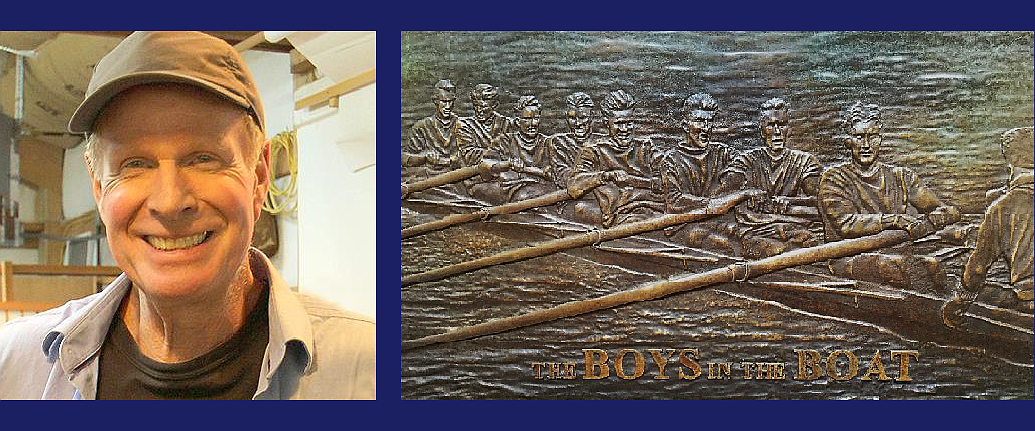Jeff Day and the Boys in the Boat
January 1, 2024 at 12:00 a.m.
On the chance that you are not aware of the noteworthy stories behind the famous phrase, here is a brief recounting:
- The Boys in the Boat was the affectionate nickname given to the ragtag Depression-era University of Washington rowing team and their inspiring journey to winning a gold medal at Hitler’s 1936 Berlin Olympics.
- That ragtag team’s incredible and deeply moving story was told in Seattle-area author Daniel James Brown’s 2013 #1 New York Times bestselling book, The Boys in the Boat.
- A major film by the same name, directed by Oscar winner George Clooney, opened on Christmas day.
- The Boys in the Boat is also the name of a bronze relief commemorating the Olympic team and their celebrated boat.
The Boys in the Boat bronze was created by Northwest artist Jeff Day to memorialize the team and his father, Chuck Day, the #2 man on the boat. Jeff actually created two bronze relief sculptures in tribute to the team’s 1936 win—one depicts the boys in the boat, one shows them standing on the dock.

Jeff Day has created two bronze relief sculptures to honor his father and the University of Washington crew team’s 1936 Olympic gold medal win in Berlin; (top) “The Boys in the Boat” (bottom) “University of Washington – 1936 Olympic Champions”
A lifelong resident of Washington state, Jeff has worked as a professional sculptor for more than half a century. His work has been shown and collected nationally and internationally, with many exhibitions in the Pacific Northwest.
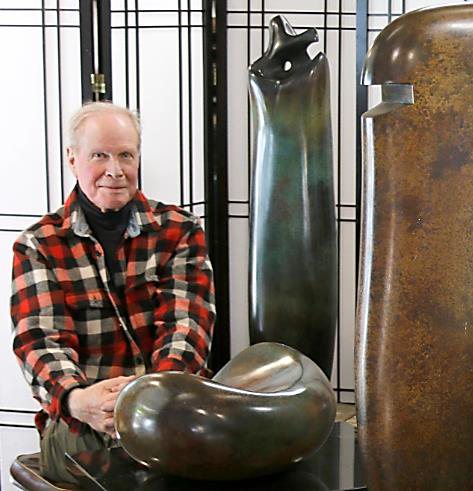 Jeff Day with some of his sculptures. His work has been shown and collected nationally and internationally, with many exhibitions in the Pacific Northwest
Jeff Day with some of his sculptures. His work has been shown and collected nationally and internationally, with many exhibitions in the Pacific Northwest
“Our family always knew that our father had won a gold medal, but he died at such a young age (47) that we didn’t really give it much thought,” says Jeff, who was only 17 when his father passed away.
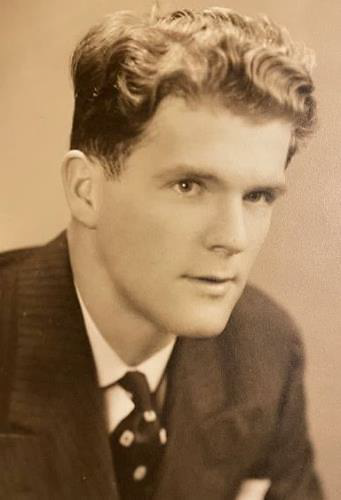 Jeff’s father, Chuck Day, was the #2 man on the boat
Jeff’s father, Chuck Day, was the #2 man on the boat
Rather than regarding their father as a heroic athlete whose triumphant return from Germany was greeted with ticker tape parades, Jeff and his siblings thought of him as the medical doctor that he was—one who served as a Naval doctor in the South Pacific during WWII and as president of the King County Medical Society.
“I think he just threw his gold medal in a sock drawer and went to work as an OB/GYN,” reflects Jeff.
Jeff does remember that after his father became ill, his former team members would gather at the family home, sit with his dad and talk in the breakfast nook. A lot of great tales were told in that nook.
But it wasn’t until the family read Brown’s book that they understood the full extent of their father’s story and the magnitude of those boys’ accomplishments. “I was astounded,” says Jeff of his reaction to the book.
“After reading The Boys in the Boat by Dan Brown, our lives were changed dramatically as we became aware of the amazing legacy that we had inherited.”
Jeff was living in China at the time. “My wife was teaching at the international school there,” he reports. Jeff was teaching bronze casting at the Nanjing Fine Arts Foundry, where he had free reign because he was casting his own pieces to send back to the U.S.
Upon learning so much about his father’s story from the book, Jeff recalls, “We saw this as an opportunity to imagine how we could reconnect with our father and give something back to the legacy. I have been making bronze sculptures for 50 years and it seemed appropriate that I should do a memorial sculpture.”
While the Day family is proud to have Jeff’s inaugural memorial sculpture displayed at the UW Rowing program, donating the impressive bronze relief was not as easy as one might expect.
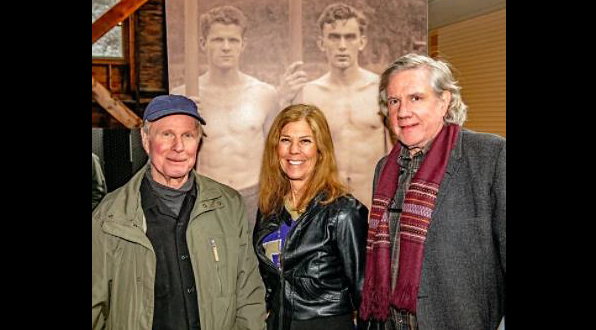
Jeff Day (left) with his sister Kris and brother John, standing in front of an image of their father, Chuck Day (left) at the University of Washington shellhouse which houses a historical record of the championship team that won the historic gold medal at the 1936 Olympics in Germany
“Tony had been a rower back in the day; he is famous and articulate,” says Jeff of his good friend. “I told him I had a piece that I wanted to show to the guys at the crew house. Tony said, ‘Okay, I’ll meet you there.’” After several starts and stalls, the large bronze relief of the 1936 crew standing is now prominently displayed at UW’s Conibear Shellhouse.
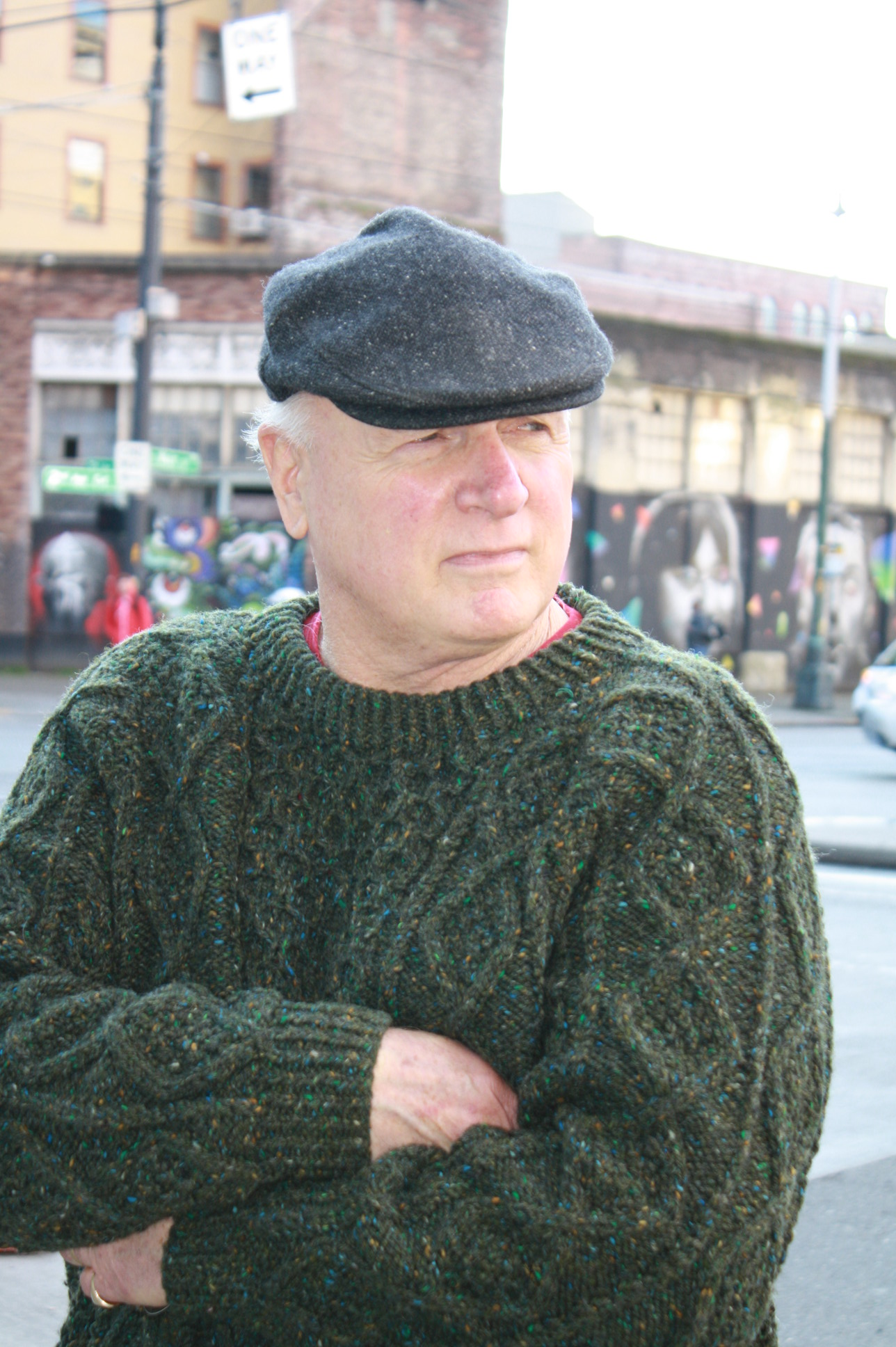 Tony Angell, photo coutesy Fosterwhite
Tony Angell, photo coutesy Fosterwhite
Carol Anderson of ARTERRA, longtime representative of Jeff’s work, encouraged him on his journey to create the commemorative bronze reliefs. “They represent a lasting, tangible, historical record, something you can both see and feel in your hands.”
 Carol Anderson of ARTERRA is the longtime representative of Jeff Day's art
Carol Anderson of ARTERRA is the longtime representative of Jeff Day's art
"It seemed so appropriate that the release of the sculptures and Jeff’s first exhibition were at the U of W, where it all began.”
ARTERRA then moved the sculptures to the Seattle Design Center, which celebrated its 50th anniversary in 2023. The bronzes are currently on exhibit in the main entry area. Future exhibition locations are in the works.
"The sculptures represent a lasting legacy and tangible record of the historic win, so lovingly and appropriately created by Jeff – the son of one of the Boys in the Boat," says Carol. "Jeff created the bronze sculptures to honor his dad and the entire U of W crew team, and their historic win."
And it was all sparked by Jeff having read Daniel James Brown’s book.
“This book was born on a cold, drizzly, late spring day when I clambered over the split-rail cedar fence that surrounds my pasture and made my way through wet woods to the modest frame house to where Joe Rantz lay dying.” So begins The Boys in the Boat, the irresistible, dramatic, and poignant story behind the University of Washington American rowing team that stunned the world at Hitler’s Olympics. Brown was introduced to Joe Rantz and his story on a chance encounter with his neighbor, Joe’s daughter Judy.
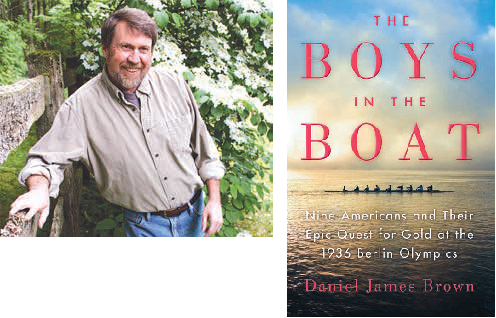 Seattle-area author Daniel James Brown wrote the best-selling book, "The Boys in the Boat"
Seattle-area author Daniel James Brown wrote the best-selling book, "The Boys in the Boat"
Joe Rantz remains the emotional heart of Brown’s book. He had been a teenager without family or prospects, abandoned as a child. “I honestly think that crew saved Joe’s life, or at least redeemed it and made it worth living,” observes Brown. “And it is their trust in one another that makes them a victorious team.”
While meeting Joe gave Brown the inspiration to write the book, many of the crew members had similar backstories. In a recent interview with Time magazine, Brown said, “These were the sons of loggers, dairy farmers, and fisherman—very Northwest kinds of kids. Virtually all of the guys that wound up in that boat were lower-middle class/working class and oftentimes unemployed. As long as they were in a boat, the university would give them a part time job—staying on the team was a way of staying in school.”
Brown noted that the UW crew were rowing against elite Ivy League schools from the East Coast, and against upper-class British teams from Oxford and Cambridge... people who grew up rowing. People love an underdog story, and the uplifting tale of the team’s Olympic gold medal against all odds grabbed the attention of millions of Americans in the depths of the Depression.
“Almost any ordinary American could identify with them...” remarked Brown. “Like everyone else, they were struggling simply to feed and clothe themselves. They remind the country of what can be done when everyone, quite literally, pulls together—a perfect melding of trust, determination, and optimism.”
To write the true story about the 1936 University of Washington crew team, Brown interviewed not only Joe Rantz, but collected as much personal information as possible from all the rowers’ families.
As it turned out, the Day family did have a remarkable piece of history about the crucial role their father played in the team’s victories. Unfortunately, they uncovered it too late to share it with Brown before he published his book.
 Jeff Day pointing to his father in the historical image at the UW Shellhouse
Jeff Day pointing to his father in the historical image at the UW Shellhouse
“He was a delightful clown even then – but there was something dead serious about him too... The misfits [as the future winning crew dubbed themselves while still on junior varsity] had no business being that good and old Chuck was the sparkplug for their morale...”
John White continues, “Charlie broke the ice with a comment that he liked the look of this group of misfits, and if we got serious we could beat the daylights out of Al’s new varsity. Charlie simply talked us into believing we were the best boat that had ever been put together, and we were from then on...
“We became show-offs, but he welded us into a unit. When things got rough or the pressure built up, Charlie always figured a new way to calm the situation down... Yes, he was the key to making our outfit a unit – he set the pace and added the sense of humor...
“He had the ability to instill into others the confidence they lacked in themselves. I suppose this was his biggest contribution to those of us who knew him. He somehow set a pattern for each of us and whether he believed we could or could not himself (and I think he did) he convinced each of us we could do a little more than any of us honestly believed we were capable of.”
Jeff and the extended Day family watched the new movie together when it opened, having booked 50 seats in the theater. On the big screen, they watched actor Thomas Elms portray Chuck Day as a young man. “The theater was packed,” reports Jeff. “There was not a dry eye in the house; everyone was in tears. It was exciting. It was overwhelming.”
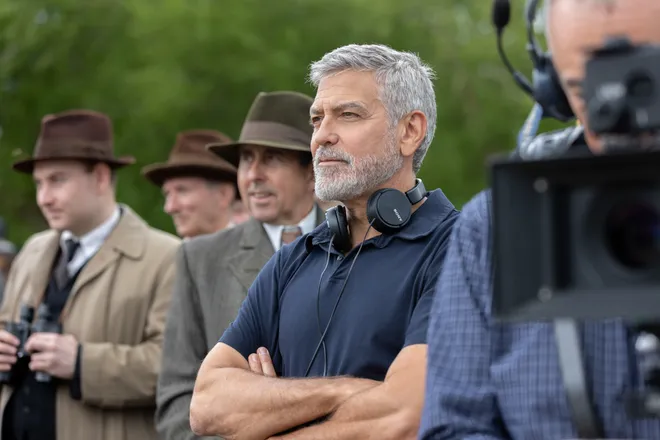 George Clooney at work directing the film, photo by Laurie Sparham courtesy US Today
George Clooney at work directing the film, photo by Laurie Sparham courtesy US Today
Sometimes a story comes along that is a true gift, and the boys in the boat is one such story. When Daniel James Brown’s epic tale was first published in 2013, Northwest Prime Time ran a cover feature about Brown and his book. Even back then, Hollywood had already come calling. “I’m beyond excited at the prospect of a feature film based on The Boys in the Boat,” said Brown in 2013. “If it happens, I think the greatest thing will be that this terrific story about some remarkable young men who long ago made it big on the world stage will once again be played out in front of the whole world.”
Ten years after the book was published and nearly 90 years after the golden team first started rowing together, the movie was launched.
The remarkable story continues; Jeff Day and his family couldn’t be prouder.
- For more information about Jeff Day, visit this link: Jeff Day (jeffdayonline.com).
- Jeff Day’s commemorative bronze reliefs of the UW’s 1936 Olympic gold medal winning team are currently on exhibit in the entry lobby at the Seattle Design Center
- To inquire about Jeff Day’s limited-edition bronze relief sculptures honoring the 1936 University of Washinton crew and their gold medal win, contact Carol Anderson of ARTERRA, which is Jeff Day’s exclusive representative for the limited-edition reliefs, available in three sizes. Carol Anderson can be reached directly at 425-922-1522 or by email: carolanderson@arterrausa.com.
